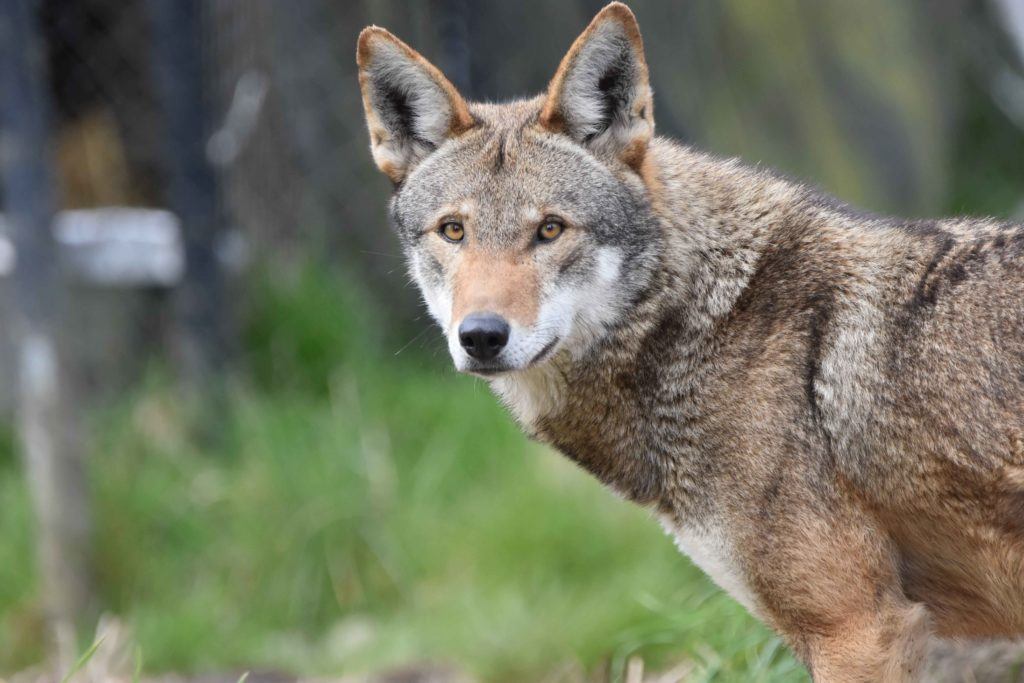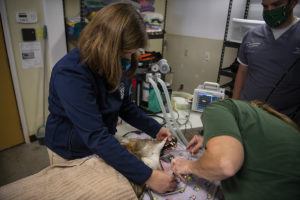
Inflammatory bowel disease is no fun. Diarrhea, vomiting, unpleasant gut sensations, even pain or fever. But if you’re an American red wolf, there are worse implications: That inflammation in your intestines might cause you to lose weight, get stressed and maybe even fail to reproduce. For an endangered species with less than 300 like you left on the planet, that’s a big worry.
That’s exactly why Point Defiance Zoo & Aquarium veterinarians have been investigating IBD in red wolves. Head veterinarian Dr. Karen Wolf first discovered that red wolves do, in fact, develop the disease, just like people and pets. Dr. Kadie Anderson, associate veterinarian is now leading the next phase of research.
Along with Dr. Wolf and three other scientists, Dr. Anderson has just begun a six-month study on four of the red wolves in the Zoo’s breeding and recovery program, located out of public view at sister zoo Northwest Trek Wildlife Park. Unlike rare wolves in the wild, they offer a rare chance to study the disease up close. The study is funded by the Dr. Holly Reed Wildlife Conservation Fund, administered by The Zoo Society, and includes a total of 11 wolves from three zoos.
Dr. Anderson’s big question? Whether diet can play a part in controlling inflammatory bowel disease in red wolves – as, in fact, it can in humans too.
Wolf exam ballet
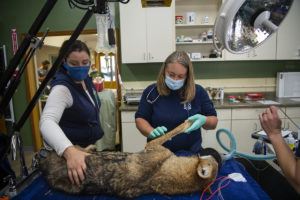
It’s a brilliantly sunny fall morning at Northwest Trek, and an entire veterinary team is just coming inside from a (socially-distanced) lunch break on a nearby log. They wash hands and get prepped in the two adjacent rooms in the wildlife park’s vet clinic: In one room, Dr. Anderson, plus co-investigator and veterinary gastroenterologist Dr. Adam Rudinsky, visiting from Ohio State University, and veterinary technician Julie Lemon; in the other room, Dr. Karen Wolf, animal curator Natalie Davis and vet tech Sara Dunleavy.
“We’re ready!” calls Dr. Anderson.
“Let’s go, then,” answers Dr. Wolf.
And through separate doors, keepers bring a crate into each room. A scent instantly fills the air: rich, pungent, grassy with a touch of urine. It’s the scent of sleeping red wolf. Gently, the keepers lift wolf 1929 onto Dr. Anderson’s table, and her sister wolf 1933 onto Dr. Wolf’s.
The red wolves, unlike other Zoo and Northwest Trek animals, are not given names, as they are cared for with as little human contact as possible and sometimes moved to other zoos to assist in their species’ national recovery program. Since the 1970s, when these native American animals had been brought to the brink of extinction, Point Defiance Zoo has been a leader in bringing back the species, working with the U.S. Fish & Wildlife Service, other zoos and the Association of Zoos & Aquariums’ Species Survival Plan (SSP) to breed generations of pups. Natalie Davis serves as the American red wolf SSP studbook keeper, and Dr. Wolf as the species’ veterinary advisor.
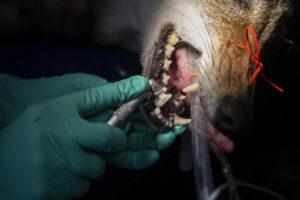
Now, thanks to leaders like Point Defiance Zoo, there are an estimated 20 red wolves living in the wild, and around 250 in human care. Six of those live at Point Defiance, and 56 at Northwest Trek.
In the clinic, two simultaneous exams begin, as graceful and choreographed as a ballet – but with a very different creature in the lead role.
In Dr. Wolf’s room, 1933 (already anesthetized) is set up with IV fluids, supplemental oxygen and gas anesthesia, then thoroughly examined by Dr. Wolf.
“It’s a great chance to palpate them all over and check up close for any problems that can’t be seen from afar,” says the veterinarian, her hands deep in the thick, rusty-brown fur.
Dunleavy, meanwhile, is busy cleaning 1933’s long white teeth, flushing the gums and checking for cavities.
“These look great,” she remarks.
Dr. Wolf’s team will also clean out those big, velvety ears, and measure weight.
Peering down the gut
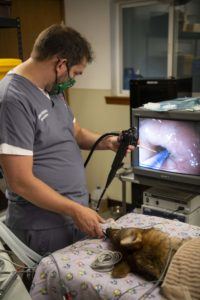
Meanwhile, in the other room, 1929 has also been given IV fluids, oxygen and gas, and now the investigation begins. Dr. Rudinsky slips a long, thin endoscopic tube down the wolf’s throat, and snakes it through her stomach and into her small intestine. Soft, squishy pink walls appear, hugely magnified, on the screen.
“Hmm, look at that,” observes the gastroenterologist. “See that flat, eroded area? It should have a wavy, fingerlike surface. And those little red bumps. These are strong indicators of inflammation in the gut.”
Dr. Rudinsky goes further with the scope, and a patch of bubbly white appears amid the pink.
“That’s the edema that comes with inflammation,” he explains, and begins taking tiny biopsy samples, withdrawing the scope each time so vet tech Julie Lemon can pry them delicately off the instrument and store them ready for sending to the lab. Dr. Anderson nods, as if this were exactly what she was expecting.
“It’s hard to begin with, diagnosing IBD in red wolves, because some show no symptoms until the disease is severe,” she explains. “When they do, it’s usually diarrhea, vomiting, loss of appetite and body condition.”
But what causes it?
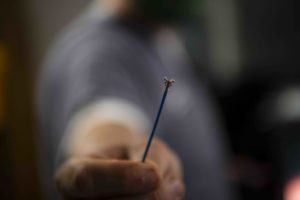
“Nobody knows for sure,” Dr. Anderson replies. “Possibly allergens. But often, we just don’t know. That’s one reason we’re doing this study – to see if diet is contributing to the disease.”
After these 11 wolves have all had samples taken from their stomachs and intestines, they’ll be switched for six months to an all-meat diet. (Currently they are fed a part-meat, part dry canine diet.) Then Dr. Anderson and her crew will repeat the examinations and biopsies, hoping to learn something if things have changed inside the wolves.
Now, hop on the scale
Biopsies complete, Dr. Rudinsky withdraws the endoscope for sterilization. Julie Lemon has just finished taking some blood samples, which will further add to what the vet team knows about wolf 1929’s health. Dr. Anderson removes the IV catheter and disconnects the oxygen, and keeper Jamie O’Brien – whose own weight is already recorded – scoops up the lean, petite wolf and steps onto the scale. In her arms, 1929’s black-dappled fur is surprisingly soft, her frame muscly.
“I love everything about caring for these animals,” O’Brien says passionately. “I grew up in North Carolina, their natural range, but until I interned at the zoo there I had never even heard of them. Now, I get to be with them every day. It’s amazing. Every morning when we arrive, they all howl, all 56 of them. You feel it, deep down. And they all have different personalities – they’re all really special.”
O’Brien steps off the scale. The team takes a deep breath. In the other room, Natalie Davis has scooped up 1933.
“Ready?” she calls. Then, with more smooth choreography, the teams swap wolves, and the process begins again.
